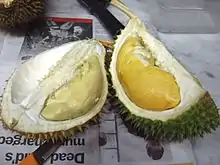| Durio crassipes | |
|---|---|
| Scientific classification | |
| Kingdom: | Plantae |
| Clade: | Tracheophytes |
| Clade: | Angiosperms |
| Clade: | Eudicots |
| Clade: | Rosids |
| Order: | Malvales |
| Family: | Malvaceae |
| Genus: | Durio |
| Species: | D. crassipes |
| Binomial name | |
| Durio crassipes Kosterm. & Soegeng | |
Durio crassipes, also known as durian hutan, is a species of flowering plant in the mallow family that is endemic to Borneo. [1]
Description
The tree grows to 60 m in height with a 20 m buttressed bole. The oval leaves are 7-11 cm long by 2.5-3 cm wide, with smooth uppersides, and with undersides covered with brown scales and hairs. The inflorescences comprise clusters of 10 or more pink to red flowers along the branches. The fruits are 7-10 cm long by 5.5-7 cm wide, covered with 5 cm-long red spines, and containing 3 cm-long black seeds encased in an edible, creamy yellow aril.[1]
Distribution and habitat
The species is known only from Sabah and Sarawak, where it is found in mixed hill forest at an elevation of 500-700 m.[1]
Usage
Since the fruits open on the branches, with the contents eaten by squirrels and hornbills, humans must climb wild trees to get the fruits.[1]
